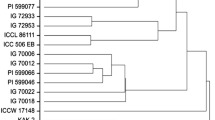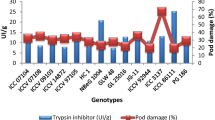Abstract
Host plant resistance is an important component for minimizing the losses due to the pod borer, Helicoverpa armigera, which is the most devastating pest of pigeonpea. An understanding of different morphological and biochemical components of resistance is essential for developing strategies to breed for resistance to insect pests. Therefore, we studied the morphological and biochemical components associated with expression of resistance to H. armigera in wild relatives of pigeonpea to identify accessions with a diverse combination of characteristics associated with resistance to this pest. Among the wild relatives, oviposition non-preference was an important component of resistance in Cajanus scarabaeoides, while heavy egg-laying was recorded on C. cajanifolius (ICPW 28) and Rhynchosia bracteata (ICPW 214). Accessions belonging to R. aurea, C. scarabaeoides, C. sericeus, C. acutifolius, and Flemingia bracteata showed high levels of resistance to H. armigera, while C. cajanifolius was as susceptible as the susceptible check, ICPL 87. Glandular trichomes (type A) on the calyxes and pods were associated with susceptibility to H. armigera, while the non-glandular trichomes (trichome type C and D) were associated with resistance to this insect. Expression of resistance to H. armigera was also associated with low amounts of sugars and high amounts of tannins and polyphenols. Accessions of wild relatives of pigeonpea with non-glandular trichomes (type C and D) or low densities of glandular trichomes (type A), and high amounts of polyphenols and tannins may be used in wide hybridization to develop pigeonpea cultivars with resistance to H. armigera.

Similar content being viewed by others
References
Ascensao L, Marques N, Pais MS (1995) Glandular trichomes on vegetative and reproductive organs of Leonotis leonurus (La-Maiacez). Ann Bot (London) 75:619–626
Association of Official Analytical Chemists (AOAC) (1984) Official methods of analysis of the Association of Official Analytical Chemists, 14th edn. Association of Official Analytical Chemists, Inc., Arlington, VA, USA, pp 187–188
Beck SD (1965) Resistance of plants to insects. Ann Rev Entomol 10:207–232
Bisen SS, Sheldrake AR (1981) The anatomy of the pigeonpea. Research Bulletin. International Crops Research Institute for the Semi Arid Tropics (ICRISAT), Patancheru, Andhra Pradesh, India
Chu CC, Natwick ET, Hanneberry TJ (2000) Susceptibility of normal-leaf and okra-leaf shape cottons to silver leaf whiteflies and relationships to trichome densities. In: Herber DJ, Richter DA (eds) Proceedings of the Beltwide Cotton Production Research Conference, San Antonio, Texas. National Cotton Council of America, Memphis, Tennessee, USA, pp 1157–1158
David H, Easwaramoorthy S (1988) Physical resistance mechanisms in insect plant interactions. In: Ananthakrishnan TN, Raman A (eds) Dynamics of insect-plant interactions: recent advances and future trends. Oxford and IBH publishing Co., New Delhi, India, pp 45–70
Dubois M, Gilles KA, Hamilton JK, Rebers PA, Smith F (1956) Colorimetric method for determination of sugars and related substances. Anal Chem 28:350–356
Frelichowski JE, Juvik JA (2001) Sesquiterpene carboxylic acids from a wild tomato species affect larval feeding behavior and survival of Helicoverpa zea and Spodoptera exigua (Lepidoptera: Noctuidae). J Econ Entomol 94:1249–1259
Ganapathy N (1996) Bio-ecology and management of spotted pod borer (Maruca testulalis (Geyer) in pigeonpea. Ph. D. Thesis, Tamil Nadu Agricultural University, Coimbatore, Tamil Nadu, India, 171 pp
Green PWC, Stevenson PC, Simmonds MSJ, Sharma HC (2002) Can larvae of the pod-borer, Helicoverpa armigera (Lepidoptera: Noctuidae), select between wild and cultivated pigeonpea [Cajanus sp. (Fabaceae)]. Bull Entomol Res 92:45–51
Green PWC, Stevenson PC, Simmonds MSJ, Sharma HC (2003) Phenolic compounds on the pod surface of pigeonpea, Cajanus cajan, mediate feeding behavior of larvae of Helicoverpa armigera. J Chem Ecol 29:811–821
Green PWC, Sharma HC, Stevenson PC, Simmonds MSJ (2006) Susceptibility of pigeonpea and some of its wild relatives to predation by Helicoverpa armigera: implications for breeding resistant cultivars. Aust J Agric Res 57:831–836
Gurr GM, McGrath D (2001) Effect of plant variety, plant age and photoperiod on glandular pubescence and host-plant resistance to potato moth (Phthorimaea operculella) in Lycopersicon spp. Ann Appl Biol 138:221–230
Hartlieb E, Rembold H (1996) Behavioral response of female Helicoverpa (Heliothis) armigera (Hub.) (Lepidoptera: Noctuidae) moths to synthetic pigeonpea (Cajanus cajan L.) kairomone. J Chem Ecol 22:821–837
International Crops Research Institute for the Semi-Arid Tropics (ICRISAT) (1992) The medium term plan. International Crops Research Institute for the Semi-Arid Tropics (ICRISAT), Patancheru, Andhra Pradesh, India
Jeffree CE (1986) The cuticle, epicuticular waxes and trichomes of plants, with reference to their structure, functions and evolution. In: Juniper BE, Southwood TRE (eds) Insects and the plant surface. Edward Arnold Publishers Ltd., London, UK, pp 23–64
Kranthi KR, Jadhav DR, Kranthi S, Wanjari RR, Ali SS, Russell DA (2002) Insecticide resistance in five major insect pests of cotton in India. Crop Prot 21:449–460
Lowry OH, Rosebrough NJ, Farr AL, Randall RJ (1951) Protein measurement with folin phenol reagent. J Biol Chem 193:265–275
MacFoy CA, Dabrowski ZT, Okech S (1983) Studies on the legume pod borer Maruca testulalis (Geyer)—VI. Cowpea resistance to oviposition and larval feeding. Insect Sci Appl 1–2:147–152
Martin JS, Martin MM, Bernays EA (1987) Failure of tannic acid to inhibit digestion or reduce digestibility of plant protein in gut fluids of insect herbivores. J Chem Ecol 13(3):605–621
Mukerji GR, Dhage AR, Desai BB, Kale AA, Mote UN, Aher RP (1993) Biochemical parameters associated with pod borer damage as influenced by maturity group and growth stages of pigeonpea [Cajanus, cajan (L.)] Millsp. Leg Res 16:51–56
Peter AJ, Shanower TG, Romeis J (1995) The role of plant trichomes in insect resistance: a selective review. Phytophaga 7:41–64
Price ML, Van Scoyoc S, Butler LG (1978) A critical evaluation of the vanillin reaction: an assay for tannins in sorghum grain. J Agric Food Chem 26:1214–1218
Ranger CM, Hower AA (2001) Role of the glandular trichomes in resistance of perennial alfalfa to the potato leafhopper (Homoptera: Cicadellidae). J Econ Entomol 94:950–957
Reed W, Lateef SS (1990) Pigeonpea: pest management. In: Nene YL, Hall SD, Sheila VK (eds) The pigeonpea. CAB International, Wallingford, UK, pp 349–374
Romeis J, Sahnower TG, Peter AJ (1999) Trichomes on pigeonpea (Cajanus Cajan) and two wild Cajanus spp. Crop Sci 39:564–569
Sahoo BK, Patnaik HP (2003) Effect of biochemicals on the incidence of pigeonpea pod borers. Indian J Plant Prot 31:105–108
Shanower TG, Yoshida M, Peter AJ (1997) Survival, growth, fecundity and behavior of Helicoverpa armigera (Lepidoptera: Noctuidae) on pigeonpea and two wild Cajanus species. J Econ Entomol 90:837–841
Sharma HC (ed) (2005) Heliothis/Helicoverpa management: emerging trends and strategies for future research. Oxford and IBH Publishers, New Delhi, India, p 469
Sharma HC (2009) Applications of biotechnology in pest management and ecological sustainability. CRC Press Taylor and Francis, Boca Raton, USA, p 526
Sharma HC, Green PWC, Stevenson PC, Simmonds MSJ (2001) What makes it tasty for the pest? Identification of Helicoverpa armigera (Hübner) feeding stimulants and location of their production on the pod-surface of pigeonpea [Cajanus cajan (L.) Millsp.]. Competitive Research Facility Project R7029 C, Final Technical Report. Department for International Development, London, UK
Singh U (1988) Antinutritional factors of chickpea and pigeonpea and their removal by processing. Plant Foods Hum Nutr 38(3):251–261
Smith CM (1989) Plant resistance to insects: a fundamental approach. Wiley, New York, USA
Srivastava CP, Pimbert MP (1990) Spatial and temporal changes in the abundance of Helicoverpa (Heliothis) armigera (Hübner) in India. Insect Sci Appl 11:869–876
Valverde PL, Fornoni J, Nunez-Farfan J (2001) Defensive role of leaf trichomes in resistance to herbivorous insects in Datura stramonium. J Evol Biol 14:424–432
Author information
Authors and Affiliations
Corresponding author
Additional information
Handling editor: Robert Glinwood
Rights and permissions
About this article
Cite this article
Sharma, H.C., Sujana, G. & Manohar Rao, D. Morphological and chemical components of resistance to pod borer, Helicoverpa armigera in wild relatives of pigeonpea. Arthropod-Plant Interactions 3, 151–161 (2009). https://doi.org/10.1007/s11829-009-9068-5
Received:
Accepted:
Published:
Issue Date:
DOI: https://doi.org/10.1007/s11829-009-9068-5




